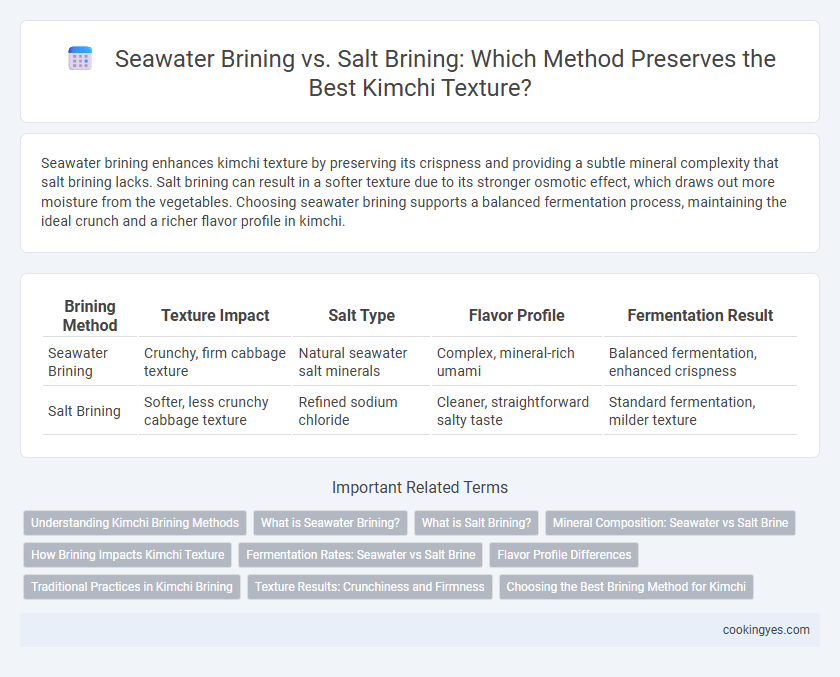Seawater brining enhances kimchi texture by preserving its crispness and providing a subtle mineral complexity that salt brining lacks. Salt brining can result in a softer texture due to its stronger osmotic effect, which draws out more moisture from the vegetables. Choosing seawater brining supports a balanced fermentation process, maintaining the ideal crunch and a richer flavor profile in kimchi.
Table of Comparison
| Brining Method | Texture Impact | Salt Type | Flavor Profile | Fermentation Result |
|---|---|---|---|---|
| Seawater Brining | Crunchy, firm cabbage texture | Natural seawater salt minerals | Complex, mineral-rich umami | Balanced fermentation, enhanced crispness |
| Salt Brining | Softer, less crunchy cabbage texture | Refined sodium chloride | Cleaner, straightforward salty taste | Standard fermentation, milder texture |
Understanding Kimchi Brining Methods
Seawater brining enhances kimchi texture by providing natural minerals like magnesium and calcium, which strengthen cabbage crispness and promote balanced fermentation. Salt brining, typically using purified salt, offers more controlled salinity but may result in a softer texture due to the lack of these minerals. Understanding the impact of mineral content in brining liquids is essential for achieving desired kimchi crunchiness and optimal fermentation flavor.
What is Seawater Brining?
Seawater brining involves using natural seawater, rich in minerals like magnesium, potassium, and calcium, to ferment kimchi, enhancing its crisp texture and umami flavor. Unlike salt brining, which relies on purified sodium chloride, seawater brining promotes a balanced microbial environment that supports lactic acid bacteria growth, resulting in a tender yet crunchy kimchi texture. This method preserves the natural oceanic minerals, contributing to improved fermentation quality and a distinctive savory taste in traditional kimchi recipes.
What is Salt Brining?
Salt brining for kimchi involves soaking cabbage or vegetables in a concentrated saltwater solution, which helps draw out moisture, firm the texture, and initiate fermentation. This method enhances the crispness of kimchi by creating an osmotic balance that preserves cell structure while promoting beneficial lactic acid bacteria growth. Compared to seawater brining, salt brining provides precise control over salt concentration, resulting in consistent texture and flavor development.
Mineral Composition: Seawater vs Salt Brine
Seawater brining for kimchi introduces a complex mineral composition, including magnesium, calcium, and potassium, which enhances fermentation and contributes to a crispier texture. In contrast, salt brining primarily relies on sodium chloride, offering fewer trace minerals, which can result in a softer, less textured kimchi. The diverse minerals in seawater promote beneficial microbial activity, improving overall flavor depth and structural integrity.
How Brining Impacts Kimchi Texture
Seawater brining enhances kimchi texture by preserving natural minerals that contribute to a crisper and more complex crunch, while salt brining often results in a softer, more uniform texture due to the absence of these elements. The mineral content in seawater brine strengthens cell walls in napa cabbage, maintaining firmness throughout fermentation. Salt brine, typically using purified sodium chloride, draws out moisture efficiently but can lead to a slightly mushier texture compared to seawater's robust structural preservation.
Fermentation Rates: Seawater vs Salt Brine
Seawater brining accelerates kimchi fermentation rates due to its rich mineral content, which promotes beneficial microbial activity more effectively than plain salt brine. The natural balance of minerals in seawater enhances the growth of lactic acid bacteria, resulting in a quicker development of the desired tangy flavor and firmer texture. Salt brine, while effective, often leads to slower fermentation and a softer kimchi texture because it lacks the trace elements found in seawater that support optimal microbial proliferation.
Flavor Profile Differences
Seawater brining for kimchi imparts a complex umami flavor and depth due to naturally occurring minerals and trace elements, enhancing the overall taste complexity. Salt brining, typically using purified salts, provides a cleaner, more straightforward saltiness which allows the natural flavors of the cabbage and spices to remain prominent. The choice between seawater and salt brining directly influences the kimchi's flavor profile, with seawater producing a richer, more mineral-driven taste compared to the crisp, balanced flavor from salt brining.
Traditional Practices in Kimchi Brining
Traditional kimchi brining predominantly utilizes salt brining, creating an ideal environment for lactic acid bacteria to ferment and develop the signature tangy flavor and crunchy texture. Seawater brining, rich in minerals like magnesium and calcium, enhances kimchi's crispness by strengthening cell walls and preserving firmness throughout fermentation. The mineral composition in traditional Korean seawater salt plays a crucial role in balancing moisture extraction and microbial activity, impacting both texture and flavor complexity.
Texture Results: Crunchiness and Firmness
Seawater brining enhances kimchi's texture by preserving optimal crunchiness and firmness due to its balanced mineral content, which strengthens cell walls during fermentation. Salt brining often results in softer kimchi as higher sodium concentration draws out excess moisture, leading to reduced crispness. Studies show that seawater-brined kimchi maintains a firmer, crispier texture preferred in traditional Korean fermentation practices.
Choosing the Best Brining Method for Kimchi
Seawater brining preserves kimchi's crisp texture due to its natural mineral content, enhancing fermentation and flavor complexity compared to standard salt brining. The balanced mineral profile in seawater promotes beneficial lactic acid bacteria growth, resulting in a more robust and crunchy kimchi. Salt brining, while effective for moisture extraction, can lead to a softer texture if used excessively, making seawater brining the preferred choice for maintaining ideal kimchi crispness.
Seawater Brining vs Salt Brining for kimchi texture Infographic

 cookingyes.com
cookingyes.com